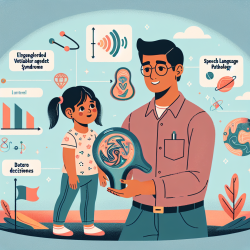Enlarged Vestibular Aqueduct Syndrome (EVAS) is a significant concern in pediatric speech-language pathology due to its association with sensorineural hearing loss (SNHL) and mixed hearing loss. A recent case report and literature review by Pinto et al. (2005) in the Brazilian Journal of Otorhinolaryngology offers valuable insights that can enhance the effectiveness of therapeutic interventions for children affected by this condition.
EVAS is characterized by an abnormal widening of the vestibular aqueduct, often leading to progressive or fluctuating hearing loss that can be congenital or acquired during childhood. The incidence of EVAS ranges from 1% to 7%, depending on the population studied. This variability underscores the importance of accurate diagnosis and tailored management strategies.
The case report by Pinto et al. analyzed three instances of EVAS, providing critical data that can inform clinical practice:
- Early Diagnosis is Crucial: The study emphasizes the importance of early diagnosis through imaging techniques such as CT scans and MRIs. Early identification of EVAS can facilitate timely interventions, such as the use of hearing aids or cochlear implants, which have been shown to improve auditory outcomes and language development.
- Comprehensive Evaluation: The authors recommend a thorough evaluation protocol, including audiometry, serological tests, and autoimmune disease markers. This comprehensive approach helps rule out other potential causes of hearing loss and ensures that the diagnosis of EVAS is accurate.
- Conservative Management: For most cases, conservative management is advised. This includes preventing head trauma and barotrauma, which can exacerbate hearing loss. The use of hearing aids is recommended to support auditory function and language development.
- Genetic Counseling: Given the hereditary nature of EVAS, genetic counseling can be beneficial for affected families. Understanding the genetic basis of the condition can help in planning for future pregnancies and in managing expectations for hearing outcomes.
- Cochlear Implants: The study highlights the effectiveness of cochlear implants in children with EVAS. These devices can significantly improve hearing and facilitate integration into regular school environments. The success of cochlear implants in EVAS patients suggests that early surgical intervention should be considered for eligible children.
To improve your practice and outcomes for children with EVAS, consider implementing the following strategies:
- Routine Screening: Incorporate routine hearing screenings and imaging studies for children presenting with SNHL or mixed hearing loss.
- Multidisciplinary Approach: Collaborate with otolaryngologists, audiologists, and genetic counselors to provide comprehensive care.
- Parental Education: Educate parents about the importance of early diagnosis and the potential benefits of hearing aids and cochlear implants.
- Ongoing Research: Stay updated with the latest research on EVAS to continually refine your therapeutic approaches.
By leveraging the findings from Pinto et al.'s study, practitioners can make data-driven decisions that enhance the quality of care for children with EVAS.
To read the original research paper, please follow this link: Enlarged vestibular aqueduct syndrome: report of 3 cases and literature review.










